Collection of Data to Inform the Implementation of a Discards Ban: Scottish Marine and Freshwater Science Vol 7 No 12
This report describes a trial of self-sampling by fishermen as a means of collecting information on discards. The project was funded by the Scottish Government under the Fishing Industry Science Alliance (FISA) and carried out in partnership with the Shet
4 Results
4.1 Sample Collection
A total of six vessels were enlisted in the self-sampling programme, representing about one-quarter of the Shetland whitefish fleet. These included two vessels using seine nets, two using single trawls and two using twin trawls [6] .
The vessels returned a total of 72 samples of discards between May 2014 and February 2015, with a total weight of 5,885 kg (Table 2). Most of the samples were collected in the waters around Shetland (Figure 1), with almost half (46%) of the samples coming from the two ICES statistical rectangles east of Shetland.
Two vessels returned samples dependably throughout the programme and accounted for the majority (61%) of the discard samples returned. Other vessels enlisted in the programme tended to return samples initially, but failed to continue doing so in the longer-term. As a result, the majority of the fishermen's discard samples were received from vessels using single or twin trawls; only nine samples were received from seine net vessels.
All but three of the samples (96%) comprised two boxes of fish, with a mean box weight of 41.2 kg (± 0.7 kg).
From the information recorded on the sample record sheets, the discard samples represented about 25% of the total quantity of fish discarded from the sampled catches, on average (Table 2). This percentage tended to be slightly higher for the seine net and single-trawl fishing vessels and slightly lower for the twin-trawl vessel, and especially the twin-trawl vessels with cameras.
Slightly more than one-third (36%) of the samples came from the tow indicated by the random number on the record sheet issued to the vessel. For the remaining samples (64% of the total) the tow number recorded on the record sheet did not match the random number.
Figure 1: Distribution of the fishermen's discard samples collected during this study. Numbers indicate the total number of samples collected in each ICES statistical rectangle.
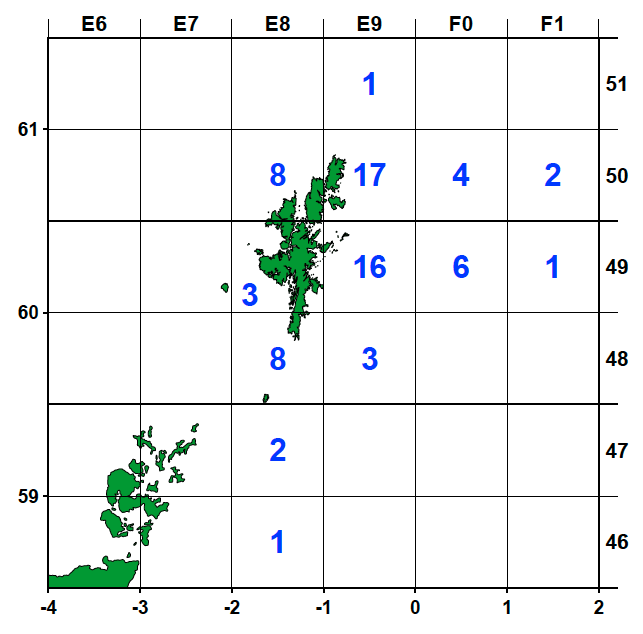
Table 2: The number of samples returned, and the total sample weight, by fishing gear type and overall. Also shown are: the mean sample weights, the mean box weights, and the mean percentage of the discards from the catch that were included in the samples (± the standard error of the means in each case). Most samples comprised two boxes.
| Seine |
Single Trawl |
Twin Trawl |
Twin Trawl |
ALL Gears |
|
|---|---|---|---|---|---|
| No. of Samples |
9 |
31 |
23 |
9 |
72 |
| Total Sample Weight (kg) |
797 |
2,485 |
1,862 |
742 |
5,886 |
| Mean Sample Wt. (kg) |
88.6 ± 2.5 |
80.1 ± 1.4 |
84.2 ± 3.1 |
77.2 ± 2.9 |
82.1 ± 1.4 |
| Mean Box Wt. (kg) |
44.3 ± 2.5 |
40.1 ± 0.7 |
42.5 ± 1.5 |
38.9 ± 1.3 |
41.2 ± 0.7 |
| Sample as % of Discards |
27% ± 7% |
28% ± 5% |
22% ± 3% |
16% ± 2% |
25% ± 2% |
4.2 Composition of Discards
More than 25 species of fish were recorded in the fishermen's discard samples (Table 3). The samples were dominated by three species; hake, saithe and cod, which together accounted for two-thirds of the total sample weight (Figure 2, Table 5). Hake was the most abundant single species, accounting for about one-third of the sample weight on its own, while saithe and cod accounted for similar percentages.
Other species that were present in the samples in relatively large quantities included gurnards, rays and ling (Figure 2). Together, eight species accounted for more than 90% of the discard sample weight (Figure 2).
Based on discussions with fishermen, and the analysis of the fishermen's discard samples, several principal reasons for discarding were identified (Table 4), of which lack of quota was perhaps the most important (in that it accounted for the greatest quantity of fish discarded). 'Lack of quota' in this context refers to a lack of quota over the course of the year, not during an individual fishing trip; most skippers try to manage their available quota so that it last the whole year. (Available quota includes in-year swaps, trades and transfers).
The other principal reasons for discarding were lack of market demand and size limits (for fish below or close to minimum landing sizes).
Figure 2: Discard sample composition: the average proportion (by weight) of the principal species in the fishermen's discard samples (all gear types). Error bars show the standard error of the mean. The line shows the cumulative percentage (on the right-hand axis).
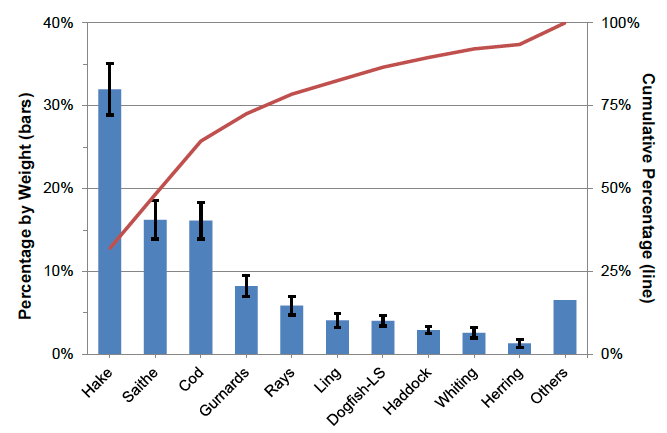
Table 3: The species recorded in the fishermen's discard samples, with the average weight of each per sample by fishing gear type and overall.
|
|
Fishing Gear |
|||||
|---|---|---|---|---|---|---|
| Seine Net |
Single Trawl |
Twin Trawl |
ALL Gears |
|||
| No. of samples: |
9 |
31 |
23 |
9 |
72 |
|
| Species |
kg / sample |
|||||
| Hake |
Merluccius merluccius |
33.3 |
20.9 |
28.2 |
27.8 |
25.6 |
| Cod |
Gadus morhua |
20.0 |
11.0 |
20.4 |
0.0 |
13.8 |
| Saithe |
Pollachius virens |
0.1 |
10.7 |
12.1 |
41.0 |
13.6 |
| Gurnards |
Chelidonichthys cuculus |
7.6 |
7.7 |
6.0 |
2.5 |
6.5 |
| Raja naevus |
10.4 |
5.5 |
1.5 |
4.6 |
4.7 |
|
| Ling |
Molva molva |
0.6 |
4.6 |
2.5 |
4.2 |
3.4 |
| Dogfish- |
Scyliorhinus canicula |
7.0 |
3.5 |
2.3 |
0.9 |
3.2 |
| Haddock |
Melanogrammus aeglefinus |
1.1 |
3.6 |
2.0 |
0.5 |
2.4 |
| Whiting |
Merlangius merlangus |
0.7 |
4.4 |
1.0 |
0.2 |
2.3 |
| Plaice |
Pleuronectes platessa |
1.1 |
1.4 |
1.0 |
0.0 |
1.1 |
| Herring |
Clupea harengus |
0.1 |
1.6 |
1.0 |
- |
1.0 |
| Skate-Common |
Dipturus batis |
0.9 |
1.7 |
0.5 |
- |
1.0 |
| Horse Mackerel |
Trachurus trachurus |
1.4 |
1.2 |
0.4 |
0.4 |
0.9 |
| Mackerel |
Scomber scombrus |
0.0 |
0.4 |
1.1 |
- |
0.6 |
| Dabs |
Limanda limanda |
1.0 |
0.3 |
0.1 |
0.0 |
0.3 |
| Megrim |
Lepidorhombus whiffiagonis |
0.0 |
0.1 |
0.3 |
0.0 |
0.2 |
| Witch |
Glyptocephalus cynoglossus |
0.0 |
0.2 |
- |
0.0 |
0.1 |
| Red Fish |
Sebastes spp. |
- |
0.2 |
0.0 |
0.1 |
0.1 |
| Lemon Sole |
Microstomus kitt |
- |
0.1 |
0.0 |
- |
0.1 |
| Blue Whiting |
Micromesistius poutassou |
- |
0.1 |
0.0 |
- |
0.1 |
| Monk |
Lophius piscatorius |
- |
0.1 |
0.1 |
- |
0.1 |
| Wolffish |
Anarhichas lupus |
- |
0.1 |
- |
- |
0.0 |
| Tusk |
Brosme brosme |
- |
- |
- |
0.1 |
0.0 |
| 2.6 |
0.5 |
0.1 |
0.0 |
0.6 |
||
| 0.5 |
0.1 |
0.2 |
0.0 |
0.2 |
||
| Total |
88.6 |
80.1 |
81.0 |
82.4 |
81.7 |
|
Notes
1 Vessel operating under the Cod Catch Quota Scheme. See footnote on p. 10
2 Rays were not identified to species, but included cuckoo rays ( R. naevus) and thornback rays ( R. clavata).
3 'Other fish' commonly included Argentines ( Argentina sphyraena) and Norway pout ( Trispoterus esmarkii).
4 Non-fish included cephalopods, echinoderms, crustaceans and molluscs.
Table 4: The assumed primary reasons for discarding the principal species discarded (based on discussions with fishermen and others, and analysis of the fishermen's discard samples).
| Species |
Main Reason for Discarding |
|---|---|
| Hake |
|
| Saithe |
|
| Cod |
|
| Gurnards |
No Market |
| Rays |
No Market (small fish) |
| Ling |
|
| Lesser-Spotted Dogfish |
No Market |
| Whiting |
|
| Haddock |
|
| Herring |
1 Lack of quota over the course of the year (including in-year swaps, trades and transfers).
2 Fish below or close to the minimum landing size.
4.2.1 Comparison of Fishing Gears
The composition of the fishermen's discard samples was broadly similar between the different types of fishing gear (Figure 3, Table 5), with a few exceptions. In particular, relatively few ling and almost no saithe were encountered in the samples from seine net vessels, while saithe accounted for a relatively high proportion of the discards from the camera-equipped twin-trawl vessel. As would have been expected, cod was almost entirely absent from the discards of the latter vessel (a single cod was recorded).
Overall, there was a significant difference between the discard compositions of the four gear categories (Kruskal-Wallis, H = 8.21, P < 0.05). However, this can be explained by the absence of cod from the discard samples from the camera-equipped twin-trawler. There was no significant difference between the discard compositions of the other three fishing gear types (Kruskal-Wallis, H = 3.01, P > 0.05), or between the four gear types if cod is excluded from the analysis (Kruskal-Wallis, H = 7.22, P > 0.05).
Figure 3: Discard sample composition by fishing gear type: the average percentage (by weight) of the principal species in the fishermen's discard samples by fishing gear type. Error bars show the standard error of the mean.
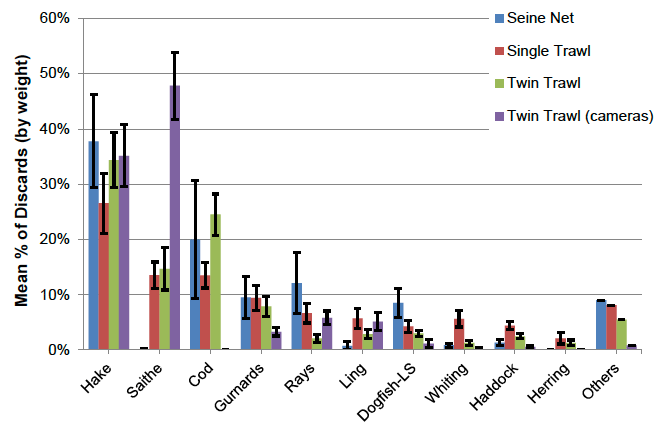
Table 5: Discard sample composition by fishing gear type: The average percentage (by weight) of each species in the fishermen's discard samples by fishing gear type and for all gears combined, and the standard error of the mean ( SE) in each case. Species are ranked in decreasing order of their percentage in all the fishing gears combined.
| Seine |
Single Trawl |
Twin |
Twin Trawl |
ALL |
||||||
|---|---|---|---|---|---|---|---|---|---|---|
| Mean |
SE |
Mean |
SE |
Mean |
SE |
Mean |
SE |
Mean |
SE |
|
| Hake |
37.8% |
8.4% |
26.6% |
5.4% |
34.3% |
5.0% |
35.2% |
5.6% |
31.5% |
3.1% |
| Saithe |
0.1% |
0.1% |
13.5% |
2.4% |
14.7% |
3.8% |
47.8% |
6.0% |
16.5% |
2.3% |
| Cod |
20.0% |
10.6% |
13.5% |
2.3% |
24.5% |
3.7% |
0.0% |
0.0% |
16.2% |
2.2% |
| Gurnards |
9.5% |
3.8% |
9.4% |
2.3% |
7.9% |
1.8% |
3.3% |
0.7% |
8.2% |
1.2% |
| Rays |
12.1% |
5.5% |
6.7% |
1.8% |
2.1% |
0.7% |
5.8% |
1.2% |
5.8% |
1.1% |
| Ling |
0.7% |
0.7% |
5.7% |
1.7% |
2.9% |
0.8% |
5.1% |
1.7% |
4.1% |
0.8% |
| Dogfish- LS |
8.6% |
2.6% |
4.3% |
1.1% |
3.0% |
0.5% |
1.2% |
0.7% |
4.0% |
0.6% |
| Whiting |
0.9% |
0.4% |
5.7% |
1.5% |
1.3% |
0.5% |
0.2% |
0.1% |
3.0% |
0.7% |
| Haddock |
1.3% |
0.5% |
4.4% |
0.8% |
2.5% |
0.4% |
0.5% |
0.2% |
2.9% |
0.4% |
| Herring |
0.1% |
0.1% |
2.1% |
1.0% |
1.3% |
0.5% |
0.0% |
0.0% |
1.3% |
0.5% |
| Plaice |
1.2% |
0.7% |
1.7% |
0.6% |
1.3% |
0.6% |
0.0% |
0.0% |
1.3% |
0.3% |
| Skate-Common |
1.0% |
0.5% |
2.1% |
0.6% |
0.7% |
0.5% |
0.0% |
0.0% |
1.2% |
0.3% |
| Horse Mackerel |
1.8% |
0.9% |
1.5% |
0.5% |
0.6% |
0.2% |
0.5% |
0.3% |
1.1% |
0.3% |
| Mackerel |
0.0% |
0.0% |
0.5% |
0.3% |
1.8% |
1.6% |
0.0% |
0.0% |
0.8% |
0.5% |
| Other Fish |
3.0% |
2.3% |
0.6% |
0.4% |
0.1% |
0.1% |
0.0% |
0.0% |
0.7% |
0.3% |
| Dabs |
1.3% |
0.5% |
0.3% |
0.1% |
0.1% |
0.0% |
0.0% |
0.0% |
0.3% |
0.1% |
| Non-Fish |
0.6% |
0.2% |
0.2% |
0.1% |
0.2% |
0.1% |
0.0% |
0.0% |
0.2% |
0.1% |
| Megrim |
0.0% |
0.0% |
0.2% |
0.0% |
0.4% |
0.1% |
0.0% |
0.0% |
0.2% |
0.0% |
| Witch |
0.1% |
0.1% |
0.3% |
0.3% |
0.0% |
0.0% |
0.1% |
0.0% |
0.1% |
0.1% |
| Red Fish |
0.0% |
0.0% |
0.2% |
0.1% |
0.0% |
0.0% |
0.1% |
0.1% |
0.1% |
0.0% |
| Lemon Sole |
0.0% |
0.0% |
0.1% |
0.1% |
0.0% |
0.0% |
0.0% |
0.0% |
0.1% |
0.0% |
| Blue Whiting |
0.0% |
0.0% |
0.1% |
0.1% |
0.1% |
0.1% |
0.0% |
0.0% |
0.1% |
0.0% |
| Monk |
0.0% |
0.0% |
0.1% |
0.0% |
0.0% |
0.0% |
0.0% |
0.0% |
0.1% |
0.0% |
| Wolffish |
0.0% |
0.0% |
0.1% |
0.1% |
0.0% |
0.0% |
0.0% |
0.0% |
0.0% |
0.0% |
| Tusk |
0.0% |
0.0% |
0.0% |
0.0% |
0.0% |
0.0% |
0.1% |
0.0% |
0.0% |
0.0% |
4.2.2 Comparison with Tally Book Data
The composition of the fishermen's discard samples was broadly similar to the estimates of discard composition made by fishermen on similar vessels through the SFA's discard tally-book scheme [8] (Figure 4). Hake dominated the discards in both cases, accounting for almost identical proportions of the discards (32% in the fishermen's discard samples compared to 31% in the tally-books), followed by saithe and cod.
The percentages of cod and saithe in the discards reported through the tally-books tended to be higher than those recorded in the fishermen's discard samples (these two species made up 50% of the discards reported through the tally-books compared to 33% of the discard samples). For other species the percentages reported through the tally-books tended to be somewhat lower than in the fishermen's discard samples.
Figure 4: Comparison of composition of the fishermen's discard samples and the composition of the discards reported through the SFA's discard tally-book scheme (all fishing gears): The average percentages (by weight) of the principal species in the fishermen's discard samples and the mean percentage of each species in the discards recorded in the tally-books. Error bars show the standard error of the mean.
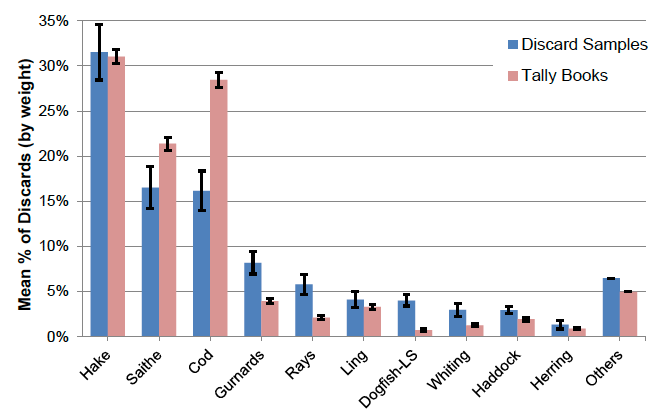
Despite these differences there was a close agreement between the composition of the fishermen's discard samples and the composition of the discards reported through the tally-book scheme). The top-six species recorded in the fishermen's discard samples, and nine of the top-10 species, were the same as those reported through the tally-books.
There was a significant relationship between the composition of the fishermen's discard samples and the composition of the discards reported through the tally-books (Spearman Rank Correlation: ρ = 0.91, P < 0.05) [9] . For the individual fishing gears the relationship was strong for single trawl vessels (Spearman Rank Correlation: ρ = 0.89, P < 0.001) and twin trawl vessels (Spearman Rank Correlation: ρ = 0.73, P < 0.001). For seine net vessels the relationship was weaker (Spearman Rank Correlation: ρ = 0.48, P < 0.05), possibly a result of the smaller amount of data from these vessels. A comparison of data from two individual vessels that participated in both projects showed a strong correlation in one case and a somewhat weaker relationship in the other (Spearman Rank Correlation: ρ = 0.86 & 0.60, P < 0.001 in both cases).
4.3 Discard Rates
4.3.1 All Species
The sample data sheets completed by the skippers indicated that 42% (by weight) of the fish caught in the sampled catches were discarded (Figure 5). This is very similar to the overall discard rate of 40% reported through the SFA's discards tally book scheme.
For the individual fishing gear types the discard rate for all species varied from 34% (twin-trawl with cameras) to 57% (seine net) (Figure 5). Again these rates were similar to those calculated from the tally book data.
There was no significant difference between the overall discard rates recorded in this study and those recorded through the SFA's discards tally book scheme, either for all gears combined or for individual gear types (Mann-Whitney U Test; all gear U = 44,858, seine net U = 635, single trawl U = 7,699, twin trawl U = 5,454; P > 0.05 in all cases).
Figure 5: Discard rates by fishing gear type: the average percentage (by weight) of the sampled catches that were discarded. Discard rates derived from the SFA discard tally book scheme are shown for comparison (no tally book data were available for camera-equipped vessels). Error bars show the standard error of the mean.
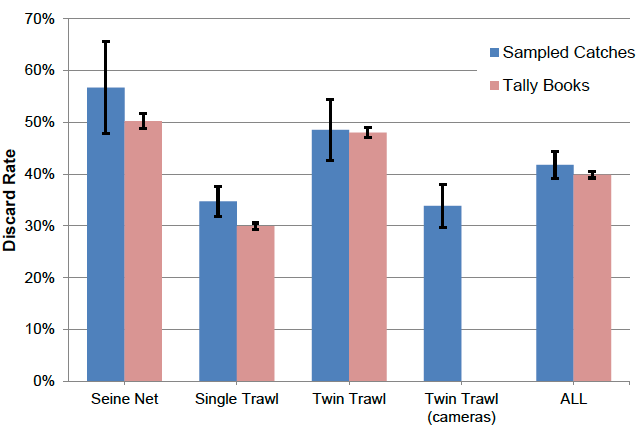
4.3.2 Individual Species
Hake had the highest discard rate overall, with an estimated 80% of the hake caught being discarded (Figure 6, Table 6). For individual fishing gear types the estimated discard rate for hake was as high as 96% (Figure 7, Table 6).
Other commercial species with high discard rates were rays, saithe, ling and cod (Figure 6, Table 6).
A number of non-target species (that is species not usually landed by whitefish fishing vessels) also had very high discard rates; 100% in many cases (Figure 6, Table 6).
Figure 6: Discard rates: the average estimated discard rate of each species (for all fishing gears). Species are grouped into 'target' species at left (those normally landed by whitefish fishing vessels) and 'non-target' species at right (not normally landed), and ranked by decreasing discard rate within each group. Error bars show the standard error of the mean.
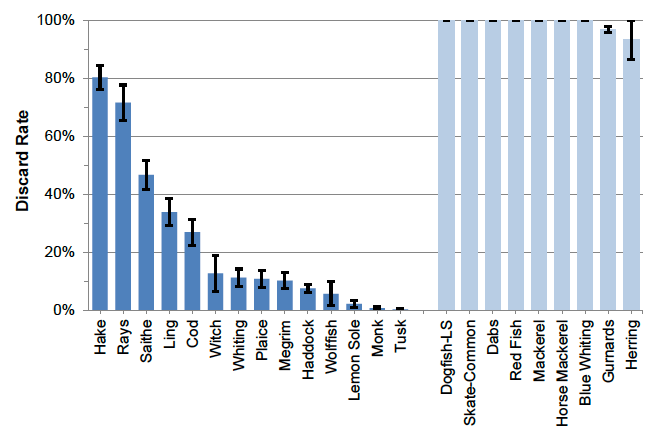
Figure 7: Discard rates by fishing gear type: the average estimated discard rate of each species. Error bars show the standard error of the mean.
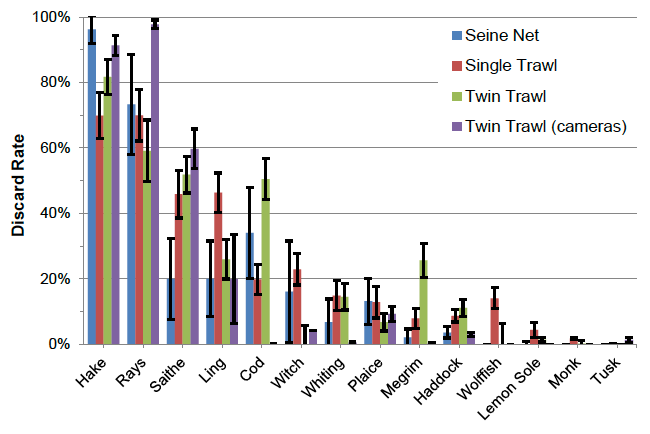
Table 6: Discard rates by fishing gear type: The average estimated discard rate of each species by fishing gear type and for all gears combined, and the standard error of the mean ( SE) in each case. Species are grouped into 'target' species (those normally landed by whitefish fishing vessels) and 'non-target' species (not normally landed), and ranked by decreasing discard rate within each group.
| Seine |
Single Trawl |
Twin |
Twin Trawl (camera) |
ALL |
||||||
|---|---|---|---|---|---|---|---|---|---|---|
| Mean |
SE |
Mean |
SE |
Mean |
SE |
Mean |
SE |
Mean |
SE |
|
| TARGET SPECIES |
||||||||||
| Hake |
96% |
4% |
70% |
7% |
82% |
5% |
91% |
3% |
80% |
4% |
| Rays |
73% |
15% |
70% |
8% |
59% |
9% |
98% |
1% |
72% |
6% |
| Saithe |
20% |
12% |
46% |
7% |
52% |
6% |
60% |
6% |
47% |
5% |
| Ling |
20% |
12% |
46% |
6% |
26% |
6% |
20% |
14% |
34% |
5% |
| Cod |
34% |
14% |
20% |
5% |
50% |
6% |
0% |
0% |
27% |
4% |
| Witch |
16% |
15% |
23% |
5% |
0% |
6% |
4% |
0% |
13% |
6% |
| Whiting |
7% |
7% |
15% |
5% |
15% |
4% |
1% |
0% |
11% |
3% |
| Plaice |
13% |
7% |
13% |
5% |
7% |
3% |
9% |
2% |
11% |
3% |
| Megrim |
2% |
3% |
8% |
3% |
26% |
5% |
0% |
0% |
10% |
3% |
| Haddock |
4% |
2% |
9% |
2% |
11% |
3% |
3% |
1% |
8% |
1% |
| Wolffish |
0% |
0% |
14% |
3% |
0% |
6% |
0% |
0% |
6% |
4% |
| Lemon Sole |
0% |
1% |
4% |
2% |
1% |
1% |
0% |
0% |
2% |
1% |
| Monk |
0% |
0% |
2% |
0% |
0% |
1% |
0% |
0% |
1% |
0% |
| Tusk |
0% |
- |
0% |
0% |
0% |
0% |
1% |
1% |
0% |
0% |
| NON-TARGET SPECIES |
||||||||||
| Dogfish- LS |
100% |
0% |
100% |
5% |
100% |
0% |
100% |
0% |
100% |
0% |
| Skate-Common |
100% |
0% |
100% |
6% |
100% |
0% |
0% |
- |
100% |
0% |
| Dabs |
100% |
0% |
100% |
6% |
100% |
0% |
100% |
- |
100% |
0% |
| Red Fish |
0% |
- |
100% |
8% |
100% |
0% |
100% |
0% |
100% |
0% |
| Mackerel |
100% |
- |
100% |
7% |
100% |
0% |
0% |
- |
100% |
0% |
| Horse Mackerel |
100% |
- |
100% |
5% |
100% |
0% |
100% |
0% |
100% |
0% |
| Blue Whiting |
0% |
- |
100% |
9% |
100% |
- |
0% |
- |
100% |
0% |
| Gurnards |
100% |
5% |
96% |
4% |
94% |
1% |
100% |
0% |
97% |
1% |
| Herring |
100% |
- |
89% |
7% |
100% |
7% |
0% |
- |
93% |
7% |
4.3.3 Comparison with Tally Book and Observer Data
The discard rates for individual species estimated from the fishermen's discard samples were broadly similar to those recorded through the SFA's discard tally book scheme, and by observers in the Data-Limited Stock project (Figure 8). Hake had the highest discard rates in all three cases.
Figure 8: Comparison of discard rates (all gears) estimated from the fishermen's discard samples with those recorded through the SFA's discard tally books and by observers in the Data-Limited Stock project. Error bars show the standard error of the mean. (Note: observer data were only available for hake, ling, plaice, megrim, lemon sole and monks).
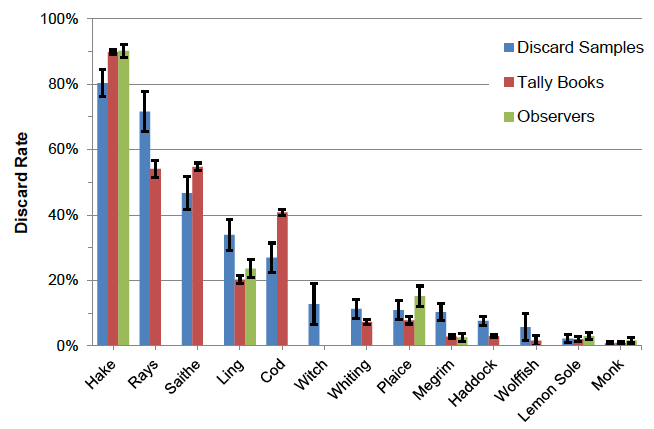
There was a significant relationship between the discard rates estimated from the fishermen's discard samples and those recorded through both the discard tally books (Spearman Rank Correlation, ρ = 0.96, P < 0.001) and via observer data (Spearman Rank Correlation: ρ = 0.94, P < 0.005) (Table 7) for all fishing gears combined. For the single and twin trawl vessels the relationships were also significant but they were weaker for the seine net vessels.
Although the statistical test showed a strong relationship between the discard rates from the fishermen's discard samples and those measured by the observers they were not significant (Table 7) for the individual fishing gears. This may reflect the relatively small sample size (observer data were available for only six species).
Table 7: Correlations between the discard rates for individual species estimated from the fishermen's discard samples and those recorded through the SFA's discard tally book scheme and by observers in the Data-Limited Stock project: Results of the Spearman Rank Correlation test between the data sets for each fishing gear type and for all gears combined. The value of rho (ρ) indicates the strength of the relationship between the two data sets on a scale from 0 (no correlation) to 1 (a perfect match). The significance levels (P) indicate the level of confidence in the results.
| Samples |
Samples |
|
|---|---|---|
| rho ( ρ ) |
rho ( ρ ) |
|
| Seine Net |
0.634* |
0.365 |
| Single Trawl |
0.939*** |
1.000 |
| Twin Trawl |
0.952*** |
0.700 |
| ALL Gears |
0.964*** |
0.943** |
Significance Levels: * P<0.05, ** P<0.01, *** P<0.001
4.4 Quantities Discarded
In 2014 Shetland whitefish vessels landed a total of 13,277 tonnes of fish from North Sea stocks (Table 8). Based on the discard rates estimated in this study, and assuming that these are representative of the whole Shetland whitefish fleet, it is estimated that a total of 6,629 tonnes of fish were discarded (implying an overall discard rate of 33%) (Table 8).
Hake is estimated to have accounted for the largest quantity of discards (Figure 9, Table 8), reflecting its relatively high discard rate. Other species estimated to be discarded in relatively large quantities included: saithe, cod, gurnards, lesser-spotted dogfish and rays.
Figure 9: Estimates of total quantities discarded: The estimated total weight of each species discarded by Shetland whitefish vessels in 2014, based on total weights landed and estimated discard rates. (North Sea stocks only).
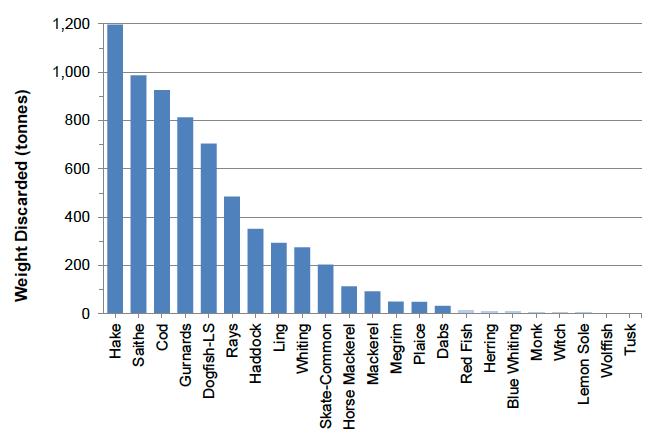
Table 8: Estimates of total weights discarded in 2014. For Shetland whitefish vessels, the total weight of each species landed, the estimated total weight discarded and the discard rate. (Weights landed are from data provided by the Shetland Fish Producer's Organisation).
| Species |
Weight Landed (tonnes) |
Weight Discarded (tonnes) |
Discard Rate |
|---|---|---|---|
| Hake |
292.6 |
1,196.2 |
80% |
| Saithe |
1,123.5 |
986.3 |
47% |
| Cod |
2,501.9 |
925.1 |
27% |
| Gurnards |
25.2 |
813.0 |
97% |
| Dogfish- LS |
0.0 |
703.6 |
100% |
| Rays |
192.5 |
485.0 |
72% |
| Haddock |
4,255.2 |
351.8 |
8% |
| Ling |
573.3 |
293.8 |
34% |
| Whiting |
2,147.4 |
274.6 |
11% |
| Skate-Common |
0.0 |
203.7 |
100% |
| Horse Mackerel |
0.0 |
113.6 |
100% |
| Mackerel |
5.7 |
92.3 |
94% |
| Megrim |
438.6 |
50.6 |
10% |
| Plaice |
405.2 |
49.6 |
11% |
| Dabs |
0.0 |
33.8 |
100% |
| Red Fish |
0.2 |
15.0 |
99% |
| Herring |
0.8 |
11.5 |
93% |
| Blue Whiting |
0.0 |
10.4 |
100% |
| Monk |
927.2 |
7.6 |
1% |
| Witch |
34.4 |
5.0 |
13% |
| Lemon Sole |
185.5 |
4.3 |
2% |
| Wolffish |
35.4 |
2.2 |
6% |
| Tusk |
18.2 |
0.1 |
0% |
| ALL Species |
13,277 |
6,629 |
33% |
4.5 Size Distributions
A total of 5,957 fish from the fishermen's discard samples were measured. Numbers at length of cod, haddock and hake are shown in Figure 10; of lemon sole, ling and megrim in Figure 11, of monks, plaice and saithe in Figure 12, of whiting and witch in Figure 13; and of rays (all species) and common skate in Figure 14.
The total numbers of each species in the samples and the estimated total weights above and below the minimum landing size ( MLS), where there is one, are shown for each fishing gear in Table 9. The proportions of each species above and below the minimum landings size are summarised in Figure 15.
With the exception of lemon sole and ling, the vast majority of the fish discarded were above the minimum landing size, where it existed (Figure 15); that is, they could legally have been landed and marketed. Of the other species, with the exception of haddock, the proportion of the discarded fish above the minimum landing size generally exceeded 95%. For hake and megrim no fish below the minimum landing size were recorded in the fishermen's discard samples. For most species this pattern tended to be similar across the different types of fishing gear (Table 9).
For some species, such as haddock and whiting, the size distribution of the discarded fish tended to be fairly narrow and concentrated around the minimum landing size (Figure 10 and Figure 13). For some others, such as cod, hake and saithe the size distribution was much wider with a high proportion of the fish above the minimum landing size (Figure 10 and Figure 12).
4.5.1 Marketable and Unmarketable Fish
Based on the proportions of each species above and below the minimum landing sizes (where relevant) [10] the total weight of the discards of each of the principal discarded species (Figure 9) were divided into potentially marketable and unmarketable (Figure 16). This indicates that most, if not all, of the discards of species such as hake, saithe, cod, haddock and ling are potentially marketable. That is, they could legally have been landed and marketed (no consideration has been given to what effect additional landings of these species might have on market demand and prices).
The largest quantities of unmarketable discards would have been of gurnards and lesser-spotted dogfish. But as these are not quota species fishermen will not be prohibited from discarding them. The largest quantities of discards of unmarketable quota species (which fishermen will not be allowed to discard) are probably of rays and ling, with an estimated 260 tonnes or so of each discarded by the Shetland whitefish fleet in 2014. The figure for rays could be affected significantly by the marketability of smaller fish.
Overall, excluding non-quota species (gurnards & lesser spotted dogfish) and species that cannot legally be landed (common skate) to which the discard ban will not apply, and based on the assumptions outlined above, it was estimated that the Shetland whitefish fleet could have discarded some 959 tonnes of unmarketable fish in 2014. This would represent about 14% of the total quantity discarded by the fleet in 2014, or 5% of the total quantity caught.
Figure 10: Percentage numbers at length of cod, haddock and hake in the fishermen's discard samples for all fishing gears combined. The percentage numbers at length of discarded hake measured by observers under the data-limited stock project are also shown (all fishing gears, to end of 2014).
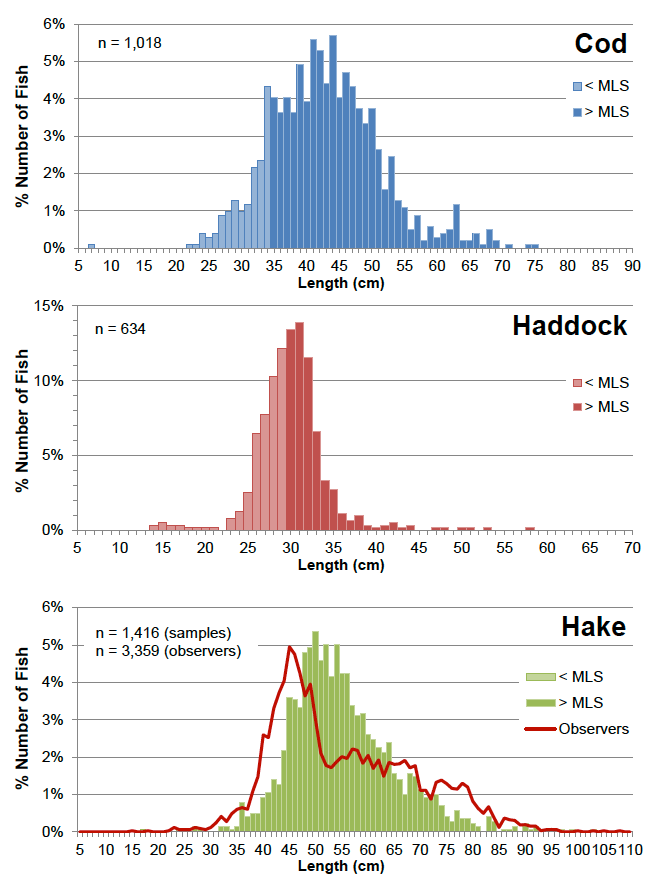
Figure 11: Percentage numbers at length of lemon sole, ling and megrim in the fishermen's discard samples for all fishing gears combined. The percentage numbers at length of discarded fish measured by observers under the data-limited stock project are also shown (all fishing gears, to end of 2014).
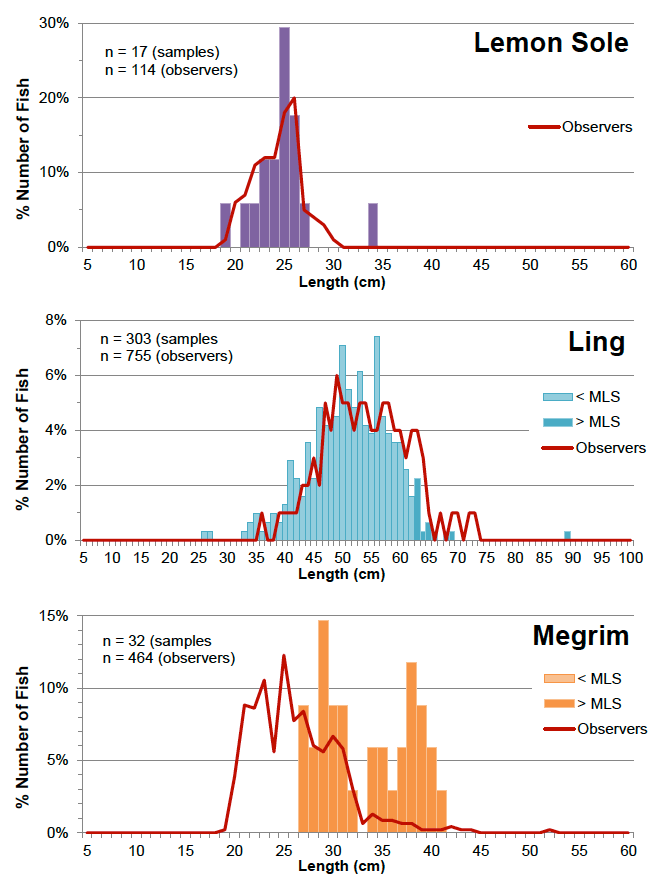
Figure 12: Percentage numbers at length of monks, plaice and saithe in the fishermen's discard samples for all fishing gears combined. The percentage numbers at length of discarded monk and plaice measured by observers under the data-limited stock project are also shown (all fishing gears, to end of 2014).
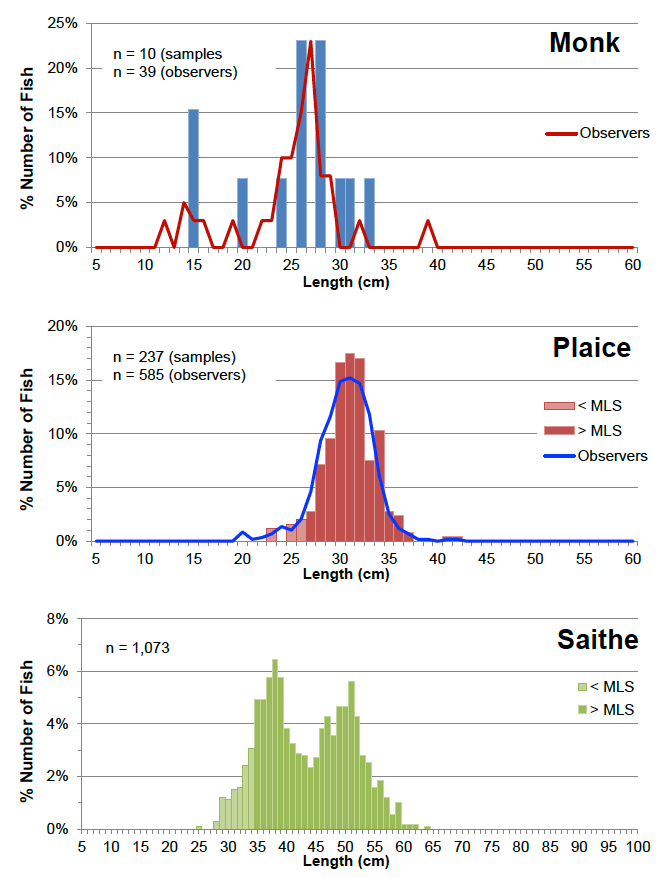
Figure 13: Percentage numbers at length of whiting and witch in the fishermen's discard samples for all fishing gears combined.
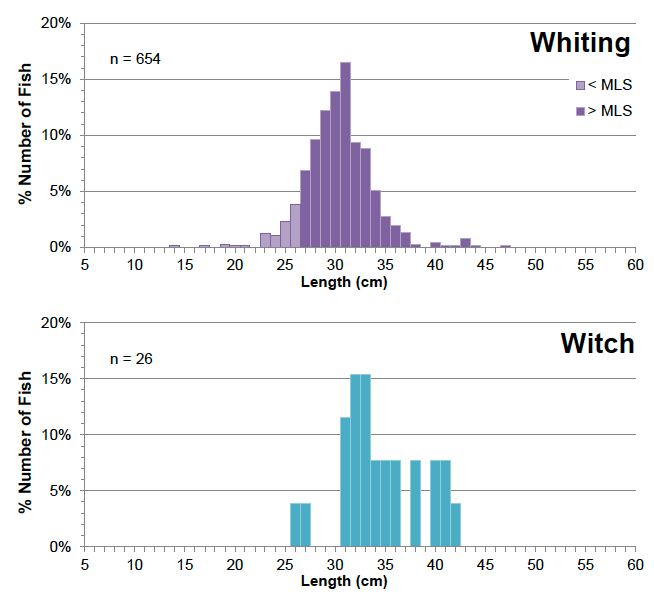
Figure 14: Percentage numbers at length of rays (all species) and common skate in the fishermen's discard samples for all fishing gears combined.
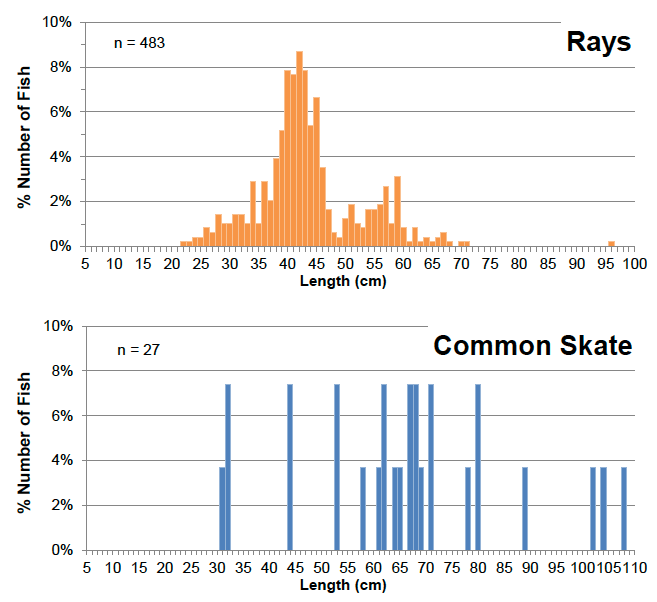
Table 9: The numbers and estimated weights of fish in the fishermen's discard samples above and below the minimum landing size for each type of fishing gear and for all gears combined and the percentages in each case. Minimum landing sizes ( MLS) are shown for each species. Where there is no MLS only total numbers caught are shown. Weights are in kg.
| Seine Net |
Single Trawl |
Twin |
Trawl |
Twin Trawl (cameras) |
ALL Gear |
|||||
|---|---|---|---|---|---|---|---|---|---|---|
| Cod |
MLS = 35 cm |
|||||||||
| No. < MLS |
22 |
12% |
107 |
24% |
28 |
7% |
1 |
100% |
158 |
16% |
| No. > MLS |
166 |
88% |
330 |
76% |
364 |
93% |
0 |
0% |
160 |
84% |
| Wt. < MLS |
7.3 |
4% |
32.5 |
11% |
8.9 |
2% |
0.2 |
100% |
48.8 |
6% |
| Wt. > MLS |
155.2 |
96% |
264.0 |
89% |
408.5 |
98% |
0.0 |
0% |
827.7 |
94% |
| Haddock |
MLS = 30 cm |
|||||||||
| No. < MLS |
15 |
45% |
183 |
44% |
67 |
40% |
9 |
56% |
274 |
43% |
| No. > MLS |
18 |
55% |
235 |
56% |
100 |
60% |
7 |
44% |
360 |
57% |
| Wt. < MLS |
2.2 |
24% |
38.0 |
31% |
14.2 |
30% |
1.8 |
40% |
56.2 |
31% |
| Wt. > MLS |
7.0 |
76% |
84.2 |
69% |
33.3 |
70% |
2.7 |
60% |
127.2 |
69% |
| Hake |
MLS = 27 cm |
|||||||||
| No. < MLS |
1 |
0% |
1 |
0% |
1 |
0% |
0 |
0% |
3 |
0% |
| No. > MLS |
278 |
100% |
532 |
100% |
435 |
100% |
168 |
100% |
1,413 |
100% |
| Wt. < MLS |
0.1 |
0% |
0.0 |
0% |
0.1 |
0% |
0.0 |
0% |
0.2 |
0% |
| Wt. > MLS |
326.7 |
100% |
663.4 |
100% |
689.4 |
100% |
253.3 |
100% |
1,933 |
100% |
| Lemon Sole |
|
No MLS | ||||||||
| No. |
0 |
--- |
14 |
3 |
0 |
17 |
||||
| Ling |
MLS = 63 cm |
|||||||||
| No. < MLS |
5 |
83% |
193 |
98% |
71 |
96% |
27 |
79% |
296 |
95% |
| No. > MLS |
1 |
17% |
3 |
2% |
3 |
4% |
7 |
21% |
14 |
5% |
| Wt. < MLS |
4.7 |
76% |
148.2 |
97% |
58.7 |
93% |
26.6 |
66% |
238.2 |
91% |
| Wt. > MLS |
1.5 |
24% |
5.1 |
3% |
4.5 |
7% |
13.5 |
34% |
24.6 |
9% |
| Megrim |
MLS = 20 cm |
|||||||||
| No. < MLS |
0 |
0% |
0 |
0% |
0 |
0% |
0 |
0% |
0 |
0% |
| No. > MLS |
2 |
100% |
14 |
100% |
17 |
100% |
1 |
100% |
34 |
100% |
| Wt. < MLS |
0.0 |
0% |
0.0 |
0% |
0.0 |
0% |
0.0 |
0% |
0.0 |
0% |
| Wt. > MLS |
0.3 |
100% |
3.9 |
100% |
6.2 |
100% |
0.2 |
100% |
10.6 |
100% |
| Monk |
No MLS |
|||||||||
| No. |
0 |
12 |
1 |
0 |
13 |
|||||
| Plaice |
|
MLS = 27 cm | ||||||||
| No. < MLS |
0 |
0% |
11 |
7% |
1 |
1% |
0 |
0% |
12 |
5% |
| No. > MLS |
25 |
100% |
138 |
93% |
76 |
99% |
1 |
100% |
240 |
95% |
| Wt. < MLS |
0.0 |
0% |
2.0 |
4% |
0.1 |
1% |
0.0 |
0% |
2.2 |
3% |
| Wt. > MLS |
9.5 |
100% |
47.7 |
96% |
26.0 |
99% |
0.3 |
100% |
83.5 |
97% |
| Saithe |
MLS = 35 cm |
|||||||||
| No. < MLS |
0 |
0% |
109 |
20% |
12 |
4% |
0 |
0% |
121 |
11% |
| No. > MLS |
1 |
100% |
434 |
80% |
255 |
96% |
262 |
100% |
952 |
89% |
| Wt. < MLS |
0.0 |
0% |
40.5 |
12% |
4.9 |
2% |
0.0 |
0% |
45.4 |
5% |
| Wt. > MLS |
1.0 |
100% |
300.7 |
88% |
276.8 |
98% |
367.1 |
100% |
945.6 |
95% |
| Whiting |
MLS = 70 cm |
|||||||||
| No. < MLS |
3 |
13% |
30 |
6% |
28 |
26% |
0 |
0% |
61 |
9% |
| No. > MLS |
21 |
88% |
490 |
94% |
79 |
74% |
3 |
100% |
593 |
91% |
| Wt. < MLS |
0.4 |
6% |
3.9 |
3% |
3.7 |
16% |
0.0 |
0% |
8.0 |
5% |
| Wt. > MLS |
6.8 |
94% |
129.6 |
97% |
19.9 |
84% |
1.7 |
100% |
158.0 |
95% |
| Witch |
No MLS |
|||||||||
| No. |
2 |
22 |
0 |
2 |
26 |
|||||
| Rays |
No MLS |
|||||||||
| No. |
145 |
231 |
44 |
63 |
483 |
|||||
| Common Skate |
|
No MLS | ||||||||
| No. |
3 |
18 |
6 |
0 |
27 |
|||||
| ALL Species |
||||||||||
| No. |
708 |
3,107 |
1,591 |
551 |
5,957 |
|||||
Figure 15: The proportions (by weight) of the fish in the fishermen's discard samples that were above and below the Minimum Landing Size.
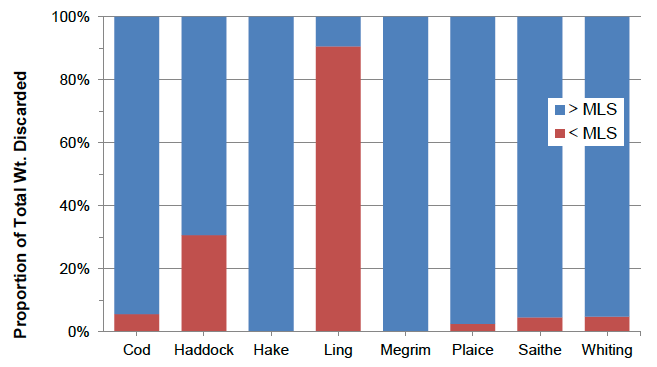
Figure 16: Total quantities discarded of marketable and unmarketable fish: The estimated total weights of the principal species discarded by Shetland whitefish vessels in 2014 that would have been marketable and unmarketable. Based on total weights landed, estimated discard rates, and proportions above and below the minimum landing size (where relevant). (See footnote on page 28 for some assumptions made).
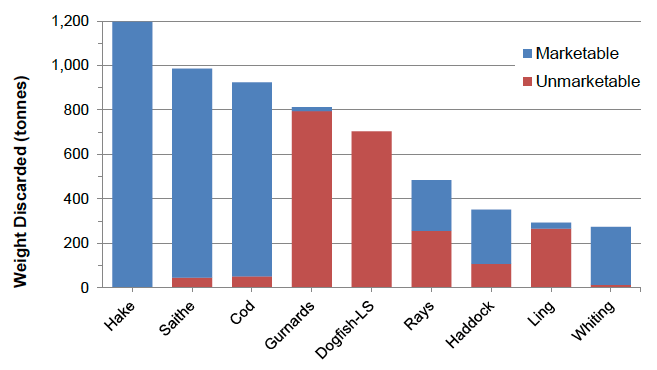
4.5.2 Comparison with Observer Data
The length frequency distributions of discarded hake, lemon sole, ling, megrim, monk and plaice measured by observers under the data-limited stock project to the end of 2014 are shown on Figure 10, Figure 11 and Figure 12.
The results of statistical comparison of the discard sample and observer data, broken down by quarter and by fishing gear, are summarised in Table 10 and Table 11. Overall, the length distributions of the hake, ling and megrim in the fishermen's discard samples were significantly different from those measured by the observers, while those of the lemon sole, monk and plaice were not. (For lemon sole, megrim and monk the number of measured fish in the fishermen's discard samples was relatively small. The same was true of the numbers of discarded monks measured by the observers).
Hake was the only species for which the length distributions were consistently significantly different for all quarters and for all fishing gears. This difference is apparent from Figure 10, with the hake in the samples tending to be larger than those measured by the observers (the difference between the peaks of the two size distributions is about 5 cm).
The length distributions of ling were significantly different overall and for each fishing gear separately, but not by quarter. In this case Figure 11 suggests that the ling in the samples tended to be smaller than those measured by the observers, although the difference is relatively small.
Overall, there was no statistically significant differences between the length distributions from the fishermen's discard samples and the observer measurements for about two-thirds of the species-quarter combinations (10 of 16 = 63%) and about half of the species gear combinations (6 of 13 = 46%).
Table 10: Results of statistical comparison of length frequencies of fish in the fishermen's discard samples and those measured by observers under the data-limited stock project, by quarter in 2014 (all fishing gears): D values from two-sample Kolmogorov-Smirnov Test. Shaded cells indicate statistically significant differences. (--- indicates no data).
| Quarter |
||||
|---|---|---|---|---|
| Species |
2 |
3 |
4 |
ALL |
| Hake |
0.260*** |
0.141*** |
0.348*** |
0.165*** |
| Lemon Sole |
--- |
0.333 |
0.268 |
0.071 |
| Ling |
0.684 |
0.214 |
0.112 |
0.141*** |
| Megrim |
0.677* |
0.184 |
0.242 |
0.578*** |
| Monk |
--- |
0.563 |
0.644* |
0.395 |
| Plaice |
0.188 |
0.258** |
0.118 |
0.094 |
Significance Levels: * P < 0.05, ** P < 0.01, *** P < 0.001
Table 11: Results of statistical comparison of length frequencies of fish in the fishermen's discard samples and those measured by observers under the data-limited stock project, by fishing gear (in 2014): D values from two-sample Kolmogorov-Smirnov Test. Shaded cells indicate statistically significant differences. (--- indicates no data).
| Fishing Gear |
||||
|---|---|---|---|---|
| Species |
Seine |
Single Trawl |
Twin Trawl |
ALL |
| Hake |
0.136*** |
0.194*** |
0.407*** |
0.165*** |
| Lemon Sole |
--- |
0.121 |
0.500 |
0.071 |
| Ling |
--- |
0.145** |
0.413*** |
0.141*** |
| Megrim |
--- |
0.188 |
0.680*** |
0.578*** |
| Monk |
--- |
0.349 |
--- |
0.395 |
| Plaice |
0.474** |
0.067 |
0.307 |
0.094 |
Significance Levels: * P < 0.05, ** P < 0.01, *** P < 0.001
4.6 Implications of the Discards Ban for Fishermen
4.6.1 Costs
It was estimated that the Shetland whitefish fleet could have discarded about 959 tonnes of unmarketable fish in 2014 (see Section 4.5.1). Under a discards ban, fishermen would in general be required to retain these fish on-board and land them.
The principal costs of handling and disposing of such unmarketable fish were assumed to be those associated with storing the fish on-board fishing vessels (boxes and ice), landing it (harbour dues), transporting it from the landing place to a place of disposal, and the disposal of the fish.
4.6.1.1 Options for Disposal
In Shetland there are three potential options for the disposal of fish waste: The Shetland Energy Recovery Plant incinerates waste with the resulting heat used to power a district heating scheme. However, this plant can only handle small quantities of fish waste (no more than about 1 tonne per week), so is probably not an option for the disposal of discards.
The landfill site operated by Shetland Islands Council is licensed to accept fish waste [11] . (The charge for disposal to landfill includes a landfill tax of £80 per tonne).
The fishmeal factory operated by Shetland Fish Products Ltd processes waste material from the salmon and pelagic fish processing industries. While this factory might be able to accept some unmarketable discards this would depend on the quantities and characteristics of the material involved and whether or not the plant was operating.
It was concluded, therefore, that while processing for fish meal might be an option for some discards, disposal to landfill represents the only guaranteed outlet for this material in Shetland at the present time.
4.6.1.2 Costs of Disposal
Based on the costs of disposal to landfill, and other known costs and charges for these elements (summarised in Table 12) it was estimated that the total cost of disposing of 959 tonnes of unmarketable fish could be about £177,000. That is less than 1% of the total gross value of landings by the Shetland whitefish fleet in 2014.
The cost of disposal is the largest single element of these estimated costs, accounting for 81% of the total. Disposal for fish meal production would avoid this disposal cost but, as outlined above, does not represent a certain outlet.
Table 12: Summary of the assumed principal costs of disposing of unmarketable fish under the discards ban.
| Item |
Calculation |
Charge |
Total |
|---|---|---|---|
| Boxes |
959 tonnes @ 40 kg / box = 23,979 boxes |
£0.43 / box |
£10,311 |
| Ice |
23,979 boxes @ 5 kg / box = 120 tonnes |
£52.00 / tonne |
£6,234 |
| Landing Dues |
959 tonnes |
£2.35 / tonne |
£2,254 |
| Skip Hire |
959 tonnes @ 6 tonnes per skip = 160 skips |
£25.00 / skip |
£3,996 |
| Transport |
160 skips @ 1.5 hours per skip |
£45.00 / hour |
£10,790 |
| Disposal (Landfill) |
959 tonnes |
£149.30 / tonne |
£143,000 |
| Total |
£176,787 |
4.6.2 Quota Uptake
Cod, hake and saithe were selected to illustrate the potential impacts of the discards ban on quota uptake by the Shetland whitefish fleet as these were the most abundant species in the fishermen's discard samples. Hake had the highest discard rate of the commercial species landed by the fleet; cod and saithe also had high discard rates and are some of the most important commercial species landed. It might be expected, therefore, that the effects of the discards ban on quota uptake would be larger for these species than for others.
The cumulative total landings of each of these species by the fleet in 2014 and the cumulative total estimated catch of each (landings + discards) based on the discard rates calculated above are shown in Figure 17. Based on the total estimated catches it is estimated that the available quota (including in-year swaps, trades and transfers) for cod would have run out on 15 th October, that for saithe on 8 th August, and that for hake on 10 th July.
These dates are shown in relation to the total cumulative landings of all species by the fleet in Figure 18. If it was assumed that all fishing had had to stop when a quota ran out (as it would under a discard ban) then significant quantities of the total potential catch would have remained uncaught. For example, if fishing stopped on 15 th October - the date the cod quota would be estimated to run out - about 21% (by weight) of the fleet's total catch of remaining species would have remained uncaught. If fishing stopped on 8 th August - the date the saithe quota was estimated to run out - then about 46% of the total catch would have remained uncaught, while on 10 th July - the date the hake quota was estimated to run out - 53% of the total would have remained uncaught. The value of the uncaught catches ranges from about £5.0 million on 15 th October, to £12.4 million on 10 th July.
Figure 17: The cumulative landings and estimated cumulative total catch (landings + discards) of cod, hake and saithe by the Shetland whitefish fleet in 2014. For each species the total available quota (including in-year swaps and trades) is shown along with the estimated date that this quota would have run out under a discards ban. (Landings and quota data provided by the SFPO).
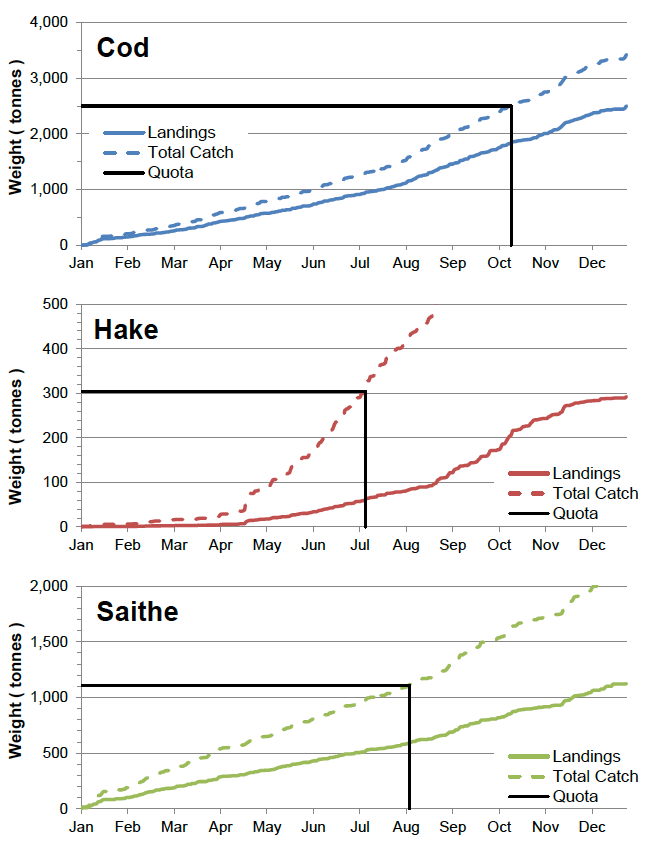
Figure 18: The total cumulative weight and value of landings (all species) by the Shetland whitefish fleet in 2014, in relation to the estimated dates that cod, hake and saithe would have run out under a discards ban. The horizontal lines indicate the total weight and value of landings made by the critical dates. (Landings data provided by the SFPO).

Contact
There is a problem
Thanks for your feedback